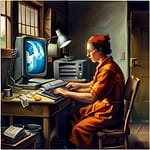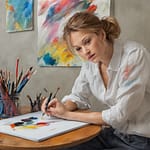Table of Contents
Being a digital painter, I often get questions about my chosen medium. Particularly from clients and traditional artists with whom I often exhibit. There is so much that is not understood about digital painting and how it differs from traditional painting (acrylic, oil, or watercolour). One key take-away:
Digital paintings are created by an artist on a computer using similar techniques that traditional artists use. Our art is NOT generated by a computer, and absolutely is not generated by an AI.
There’s no question that digital art is becoming more and more commonplace. While there are those who think that traditional art is somehow superior, this attitude is rapidly changing – because it’s unsustainable. This is especially true amongst the younger artists that are coming up.
If you’re a artist, you might be wondering about the pros and cons of each of these two mediums. Should a digital artist make the change and embrace brush and paint? Should a traditional artist leap into technology based creation?
In this article, I’ll break down the differences between the processes involved in both digital painting and traditional painting to help you discover which medium best suits you.
The Digital Painting Process
Here are a few characteristics that set digital painting apart from traditional painting:
- Easier to get started: unlike traditional art, which requires many expensive materials and tools before you can get started, the only tools digital painting requires are devices many people already own – such as a computer, tablet, or even a smartphone. Some basic software can get you going. This makes beginning your digital painting journey far less intimidating.
- Non-destructive editing: one of the key benefits to digital painting is the capacity to easily erase, change, or add parts of a painting without affecting the rest of the piece. This non-destructive process increases efficiency, and also gives the artist much more control over the final result. Unlike traditional painting, whether you’re adding, deleting, duplicating, or resizing individual elements of a painting, you have much more control and power – some of these tasks are almost impossible in traditional painting.
- More open to experimentation: inherent in this medium, and the ability to add, change, and move a painting’s elements, is the freedom to be be more experimental and creative with the work.
- Digital art is green: if you’re concerned about the environment and global warming (and you definitely should be!), it’s important for you to know that digital painting is an ecotechnology — it is much more eco-friendly than its oil, acrylic, or watercolour counterparts. For a comparison between the environmental impacts of each, please refer to this chart.
- Skills are transferable: With the spread of digital design and imagery today, being able to transfer your skills beyond the digital painting niche is a huge advantage. If you want to move into other areas of digital art such as graphic design, web design, or even animation, it’s much easier using techniques learned from digital painting and using a graphics tablet and the attendant software. There might still be a learning curve, but many techniques and principles you’ve acquired will help you create a skill set that will be highly desirable in the digital graphics and art sectors.
- Convenient: the lack of art materials and an array of painting gear makes this art form much more straightforward and convenient. Rather than having to carry around your supplies, easels, and brushes everywhere, everything you need is on your desk or can be handheld. There’s no need to go out shopping for new paints and brushes, no waiting for a canvas to dry, and no messy clean-up. Also, a computer or tablet has other uses in your life – making any initial investment far less risky.
The Traditional Painting Process
Here are a few unique aspects of traditional art that set it apart from digital painting:
- A tactile 3D surface: for a digital painting there is no “original” – it exists only as a computer file. To manifest it in the physical world so that it can be bought and displayed, it must be reproduced on canvas or specialty paper. This process is referred to as “giclée.” An acrylic painting (and especially an oil painting) will have a 3D surface from built-up paint. A digital painting, like a watercolour painting, is flat and smooth (other than the texture of the canvas).
- Unique pieces: as mentioned above, digital paintings must be reproduced on canvas or paper. There is a potential for multiple copies of a given piece to be sold. The artist can choose to make and sell one copy only, a limited edition (e.g.: 10 numbered copies), or unlimited copies – this depends upon the artist’s policies, and will affect the price of the piece. Traditional paintings are always one-of-a-kind, and can never be remade exactly – even by the original artist.
- Mistakes must be embraced: a traditional artist lacks the digital painter’s tools to modify and correct parts of the work. If a mistake is made by a traditional artist it must be embraced, and worked into the piece. Some see this as a significant disadvantage because it means the artist is forced to compromise their vision, while others see it as an advantage that might add “authenticity.”
- Needs expensive materials and equipment: traditional paiting relies on expensive and cumbersome equipment such as easels, stretched canvases, brushes, palettes, paints, etc. When the consumables run out, you need to go out and buy more.
- Not friendly to the environment: traditional painting is bad for the environment. For a comparison between the environmental impact of traditional painting vs. digital painting, please refer to this chart.




